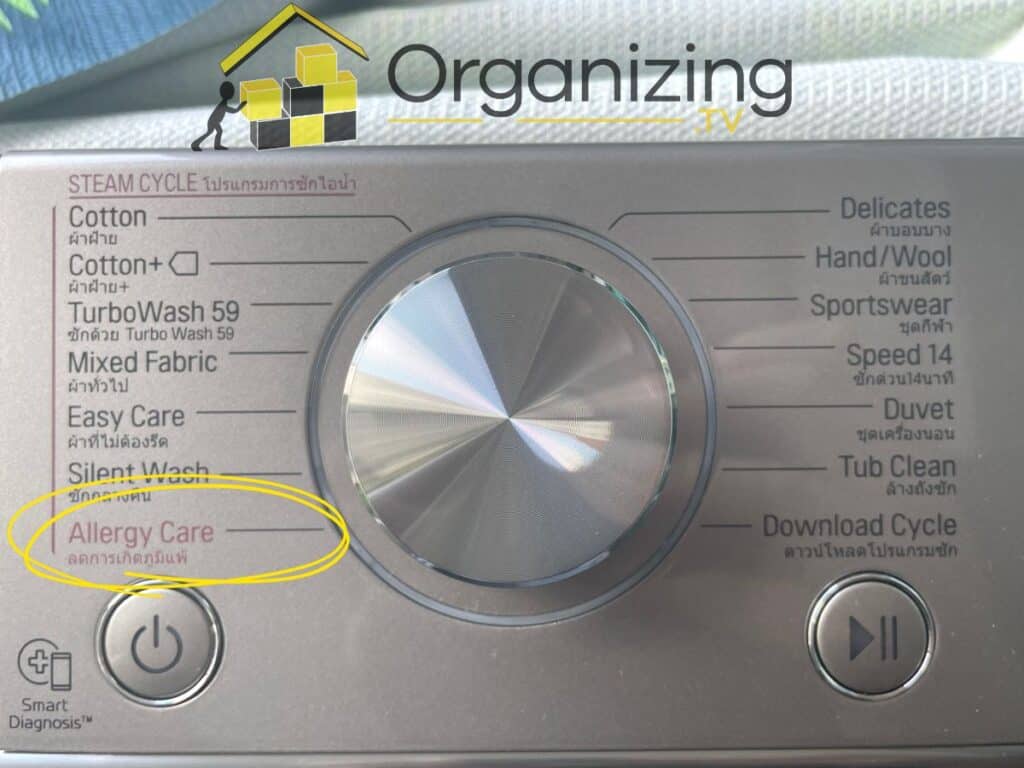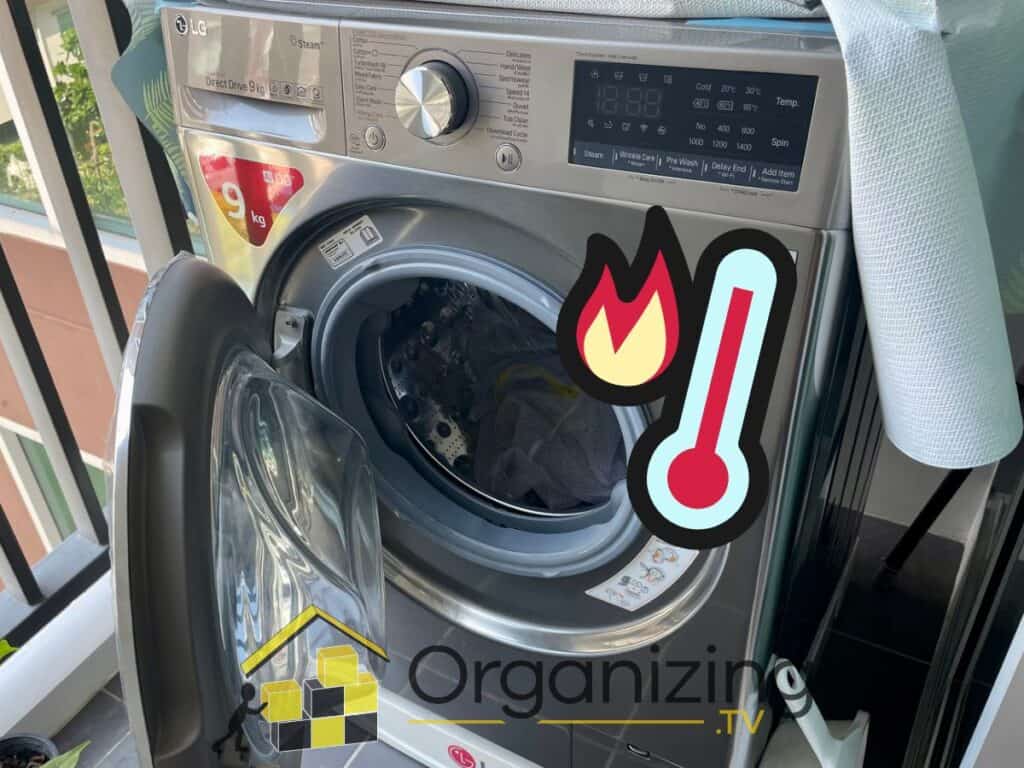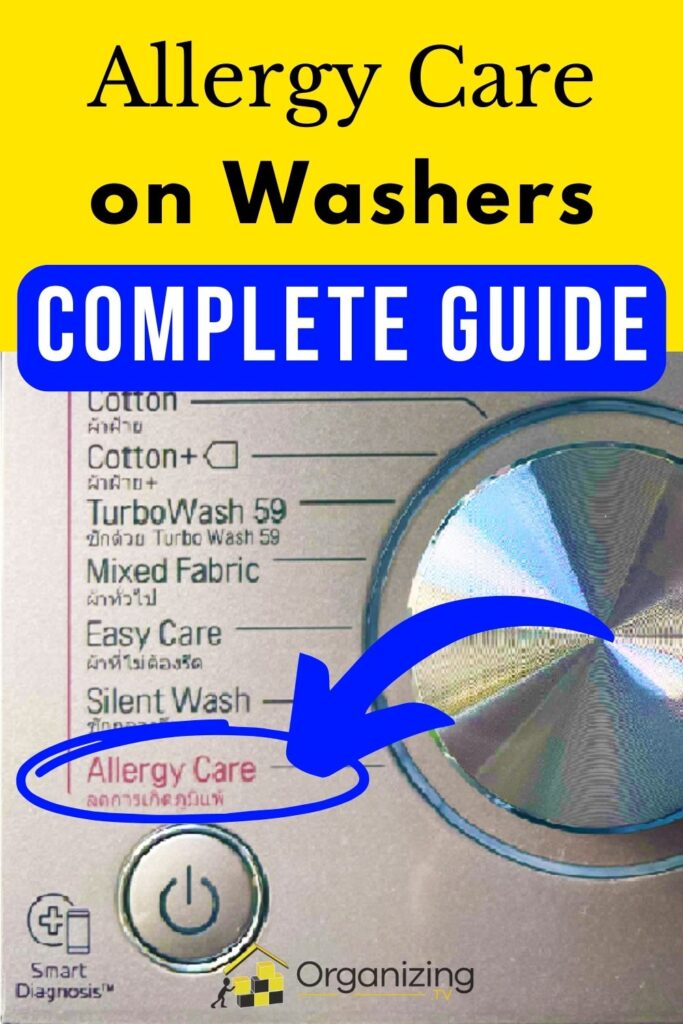Modern washing machines often have multiple wash settings, many of which get overlooked. If you’ve recently noticed your washing machine has an allergy care setting, you’re probably wondering what it is and how it works.
The allergy care setting on washers is suitable for those with dust and pollen allergies. It works hard to remove dust mites, bacteria, and yeast. Generally, an allergy care cycle consists of steam and hot water to properly remove all debris and particles. It’s also good for sensitive skin.
This article will discuss allergy care on washers in greater detail. Keep reading to learn everything you need to know about this wash cycle.
Allergy Care
Allergy care is a wash cycle that’s more intense than most standard cycles due to the higher temperatures and steam.
It’s an excellent choice if you want to remove as many dust/dirt particles as possible while ensuring that harmful bacteria and fungal spores are killed.
To get started, let’s discuss how allergy care works.
How Allergy Care Works

Steaming Technology
Most modern washers with an allergy care setting have steaming technology, which is good for killing bad-smelling bacteria and germs that may be harmful. On top of that, the steam can help to remove wrinkles from clothes, meaning you might not have to iron them once they’re dry!
The steaming will likely occur closer to the end of the wash cycle, so your clothes can stay wrinkle and bacteria-free afterward.
Extremely Hot Water Removes Allergens/Bacteria

As well as steaming technology, allergy care uses hot water (instead of warm or cold) to properly remove allergens and bacteria from clothing.
The exact water temperature will depend on the washer, but in many cases, it can be as hot as 140 degrees Fahrenheit (60 degrees Celsius)–this is the perfect temperature for removing bacteria and stains.
You’ll undoubtedly notice the difference when washing your clothes in hotter water because they’ll look cleaner, and all dust mites/bacteria are sure to be gone!
Lots of Rinsing To Wash Away Detergent
Another thing to note about the allergy care setting on a washer is that there is generally a lot of rinsing involved after the detergent has had time to clean the clothes. The extra rinsing ensures all detergent gets thoroughly washed away, meaning no traces are left that could irritate the skin.
As a result, people with sensitive skin are less likely to notice itchy or red skin patches after an allergy care wash.
When To Use Allergy Care
You should use allergy care when you have allergies, sensitivities, or skin conditions. However, be sure to only use it for clothes and other items that can handle the heat from the steam and water.
If you have any of the below allergies/sensitivities, allergy care would be a smart option for you:
- Hay fever. Hay fever occurs when you have a pollen allergy. Pollen may get on your clothes from time to time, so you need to remove all particles effectively. Allergy care is a good washer option for that.
- Dust allergy. Dust can gather on clothes over time, but it’s even more likely to accumulate on bed sheets because you likely don’t wash them as much. Putting clothes and other items like sheets in an allergy care wash should remove all dust particles.
- Sensitive skin. Allergy care is suitable for sensitive skin because it removes particles and washes away detergent better than other settings. It’s also a good option if you have eczema.
Allergy Care Considerations
Although there are many benefits to using allergy care on a washer, there are also negatives and considerations. Below are the primary allergy care considerations:

- Make sure your clothes can handle high temperatures. As you now know, allergy care uses hot water and steam to clean clothes and other items you put in your machine. Not all fabrics can handle such high temperatures, so they might shrink or become damaged. Check labels before washing clothes.
- It will likely increase your bills if you use it often. Using the allergy care setting often is likely to increase your bills because it takes more energy to heat hot water and make steam. You should be OK with this before using the setting frequently.
Is Allergy Care on Washers Good for People With Hay Fever?
Allergy care on washers is good for people with hay fever because it can effectively remove pollen and other allergens (like dust) from clothes. The hot temperatures will kill most things that give you hay fever symptoms, so you might notice a difference after using the allergy care setting.
Not only is it suitable for people with hay fever, but it’s also good for people with many other allergies.
What Detergent To Use With Allergy Care Washer Setting
The best detergent to use with the allergy care washer setting is one that cleans well. If you’re using allergy care due to sensitive skin, the best detergent is a hypoallergenic product (also known as a non-biological detergent). These detergents are less likely to cause irritation.
An example of a hypoallergenic detergent that would work well in an allergy care wash is this Persil Pro Clean Hypoallergenic Detergent, available on Amazon. It’s perfume-free and dermatologically tested, so it’s a good option for anyone with sensitive skin or allergies.
You can mix different detergents together as long as none of them irritate your skin.
Difference Between Allergy Care and Normal Wash
One of the main differences between an allergy care wash and a regular wash is that allergy care uses hotter temperatures and steam. In comparison, most standard washes use lower temperatures and no steam. Additionally, allergy care washes tend to have more rinsing than traditional settings.
Regular washes are handier if you have lots of items that can’t be washed in hot temperatures, while allergy care washes are better if you need to give your clothes a deep clean.
Conclusion
Allergy care on washers is an often overlooked setting, but it’s handy if you have allergies/sensitive skin and want to get your clothes and sheets as clean as possible. It uses high temperatures to successfully remove bacteria, dust mites, and other particles from fabrics.
Before using the allergy care setting, ensure your fabrics can handle the high temperatures. If they can’t, they may shrink or become damaged.
If you want to learn more about your washing machine’s settings check out this article.


I’m an expert wardrobe organizer and a bit of a clean freak. I created this website and its YouTube channel to share practical guides about laundry and organizing. My teachings have been featured in multiple large news publications, and I’ve self-published two wardrobe organizing books and an entire course on the subject.

